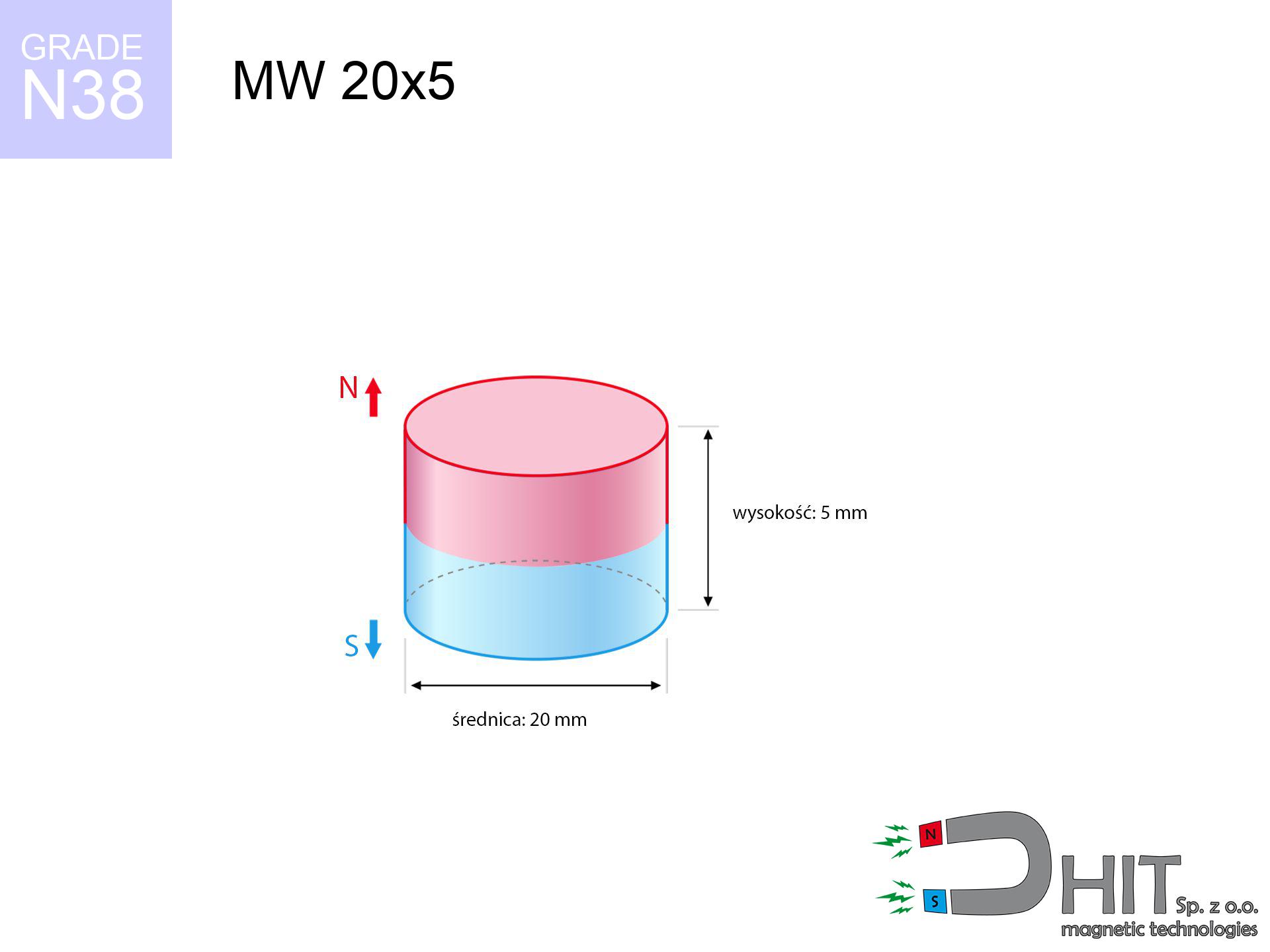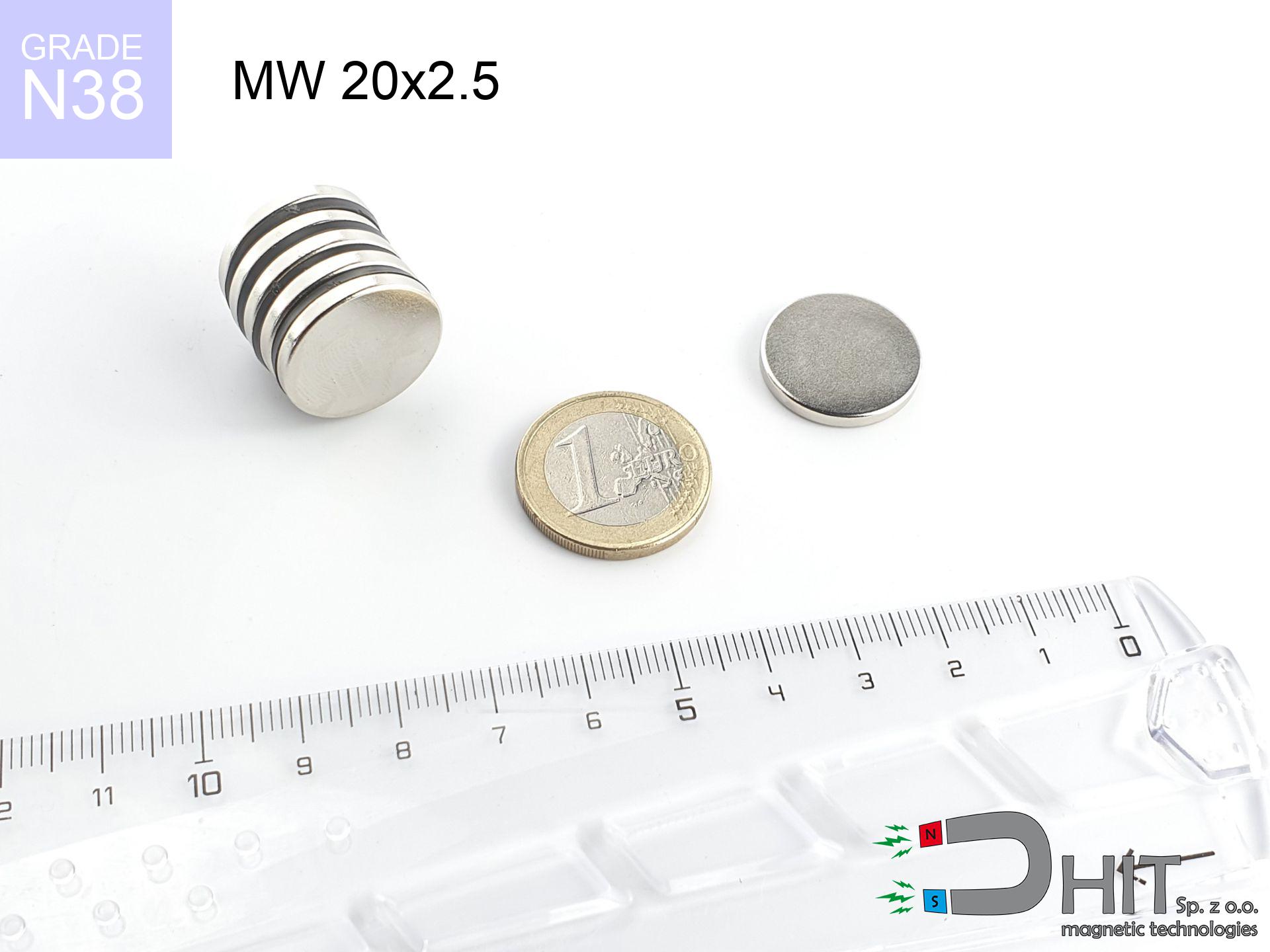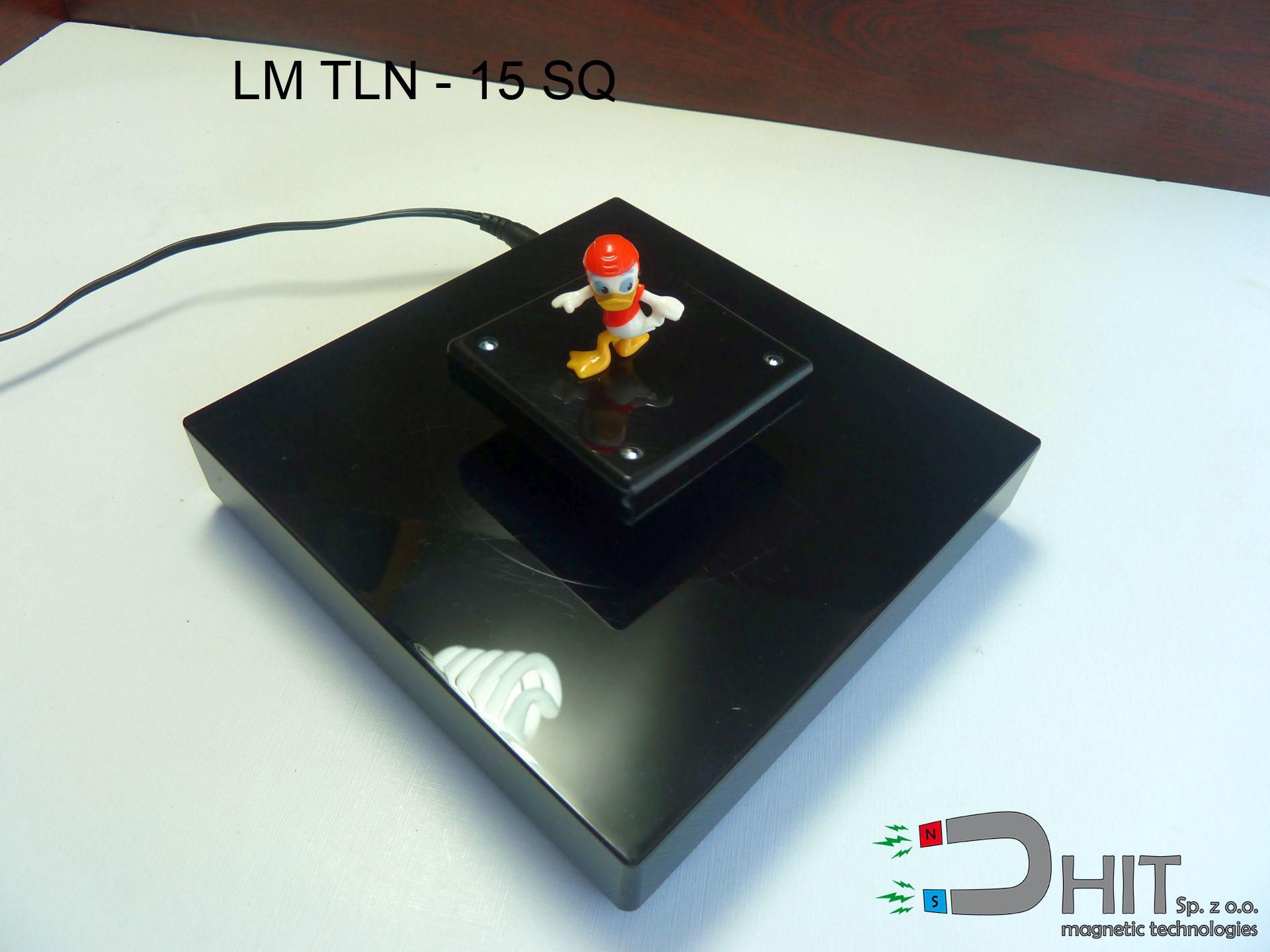MW 20x5 / N38 - cylindrical magnet
cylindrical magnet
Catalog no 010044
GTIN/EAN: 5906301810438
Diameter Ø
20 mm [±0,1 mm]
Height
5 mm [±0,1 mm]
Weight
11.78 g
Magnetization Direction
↑ axial
Load capacity
6.93 kg / 67.95 N
Magnetic Induction
277.16 mT / 2772 Gs
Coating
[NiCuNi] Nickel
5.56 ZŁ with VAT / pcs + price for transport
4.52 ZŁ net + 23% VAT / pcs
bulk discounts:
Need more?
Give us a call
+48 22 499 98 98
otherwise contact us through
contact form
the contact form page.
Parameters and structure of a magnet can be estimated using our
magnetic calculator.
Same-day shipping for orders placed before 14:00.
Technical details - MW 20x5 / N38 - cylindrical magnet
Specification / characteristics - MW 20x5 / N38 - cylindrical magnet
| properties | values |
|---|---|
| Cat. no. | 010044 |
| GTIN/EAN | 5906301810438 |
| Production/Distribution | Dhit sp. z o.o. |
| Country of origin | Poland / China / Germany |
| Customs code | 85059029 |
| Diameter Ø | 20 mm [±0,1 mm] |
| Height | 5 mm [±0,1 mm] |
| Weight | 11.78 g |
| Magnetization Direction | ↑ axial |
| Load capacity ~ ? | 6.93 kg / 67.95 N |
| Magnetic Induction ~ ? | 277.16 mT / 2772 Gs |
| Coating | [NiCuNi] Nickel |
| Manufacturing Tolerance | ±0.1 mm |
Magnetic properties of material N38
| properties | values | units |
|---|---|---|
| remenance Br [min. - max.] ? | 12.2-12.6 | kGs |
| remenance Br [min. - max.] ? | 1220-1260 | mT |
| coercivity bHc ? | 10.8-11.5 | kOe |
| coercivity bHc ? | 860-915 | kA/m |
| actual internal force iHc | ≥ 12 | kOe |
| actual internal force iHc | ≥ 955 | kA/m |
| energy density [min. - max.] ? | 36-38 | BH max MGOe |
| energy density [min. - max.] ? | 287-303 | BH max KJ/m |
| max. temperature ? | ≤ 80 | °C |
Physical properties of sintered neodymium magnets Nd2Fe14B at 20°C
| properties | values | units |
|---|---|---|
| Vickers hardness | ≥550 | Hv |
| Density | ≥7.4 | g/cm3 |
| Curie Temperature TC | 312 - 380 | °C |
| Curie Temperature TF | 593 - 716 | °F |
| Specific resistance | 150 | μΩ⋅cm |
| Bending strength | 250 | MPa |
| Compressive strength | 1000~1100 | MPa |
| Thermal expansion parallel (∥) to orientation (M) | (3-4) x 10-6 | °C-1 |
| Thermal expansion perpendicular (⊥) to orientation (M) | -(1-3) x 10-6 | °C-1 |
| Young's modulus | 1.7 x 104 | kg/mm² |
Engineering modeling of the product - data
The following data constitute the outcome of a mathematical simulation. Results are based on algorithms for the material Nd2Fe14B. Operational parameters might slightly deviate from the simulation results. Treat these data as a supplementary guide when designing systems.
Table 1: Static pull force (force vs gap) - interaction chart
MW 20x5 / N38
| Distance (mm) | Induction (Gauss) / mT | Pull Force (kg) | Risk Status |
|---|---|---|---|
| 0 mm |
2771 Gs
277.1 mT
|
6.93 kg / 6930.0 g
68.0 N
|
warning |
| 1 mm |
2573 Gs
257.3 mT
|
5.97 kg / 5975.0 g
58.6 N
|
warning |
| 2 mm |
2340 Gs
234.0 mT
|
4.94 kg / 4940.1 g
48.5 N
|
warning |
| 3 mm |
2092 Gs
209.2 mT
|
3.95 kg / 3948.3 g
38.7 N
|
warning |
| 5 mm |
1611 Gs
161.1 mT
|
2.34 kg / 2343.4 g
23.0 N
|
warning |
| 10 mm |
775 Gs
77.5 mT
|
0.54 kg / 541.6 g
5.3 N
|
low risk |
| 15 mm |
387 Gs
38.7 mT
|
0.13 kg / 135.0 g
1.3 N
|
low risk |
| 20 mm |
211 Gs
21.1 mT
|
0.04 kg / 40.2 g
0.4 N
|
low risk |
| 30 mm |
80 Gs
8.0 mT
|
0.01 kg / 5.7 g
0.1 N
|
low risk |
| 50 mm |
20 Gs
2.0 mT
|
0.00 kg / 0.4 g
0.0 N
|
low risk |
Table 2: Shear capacity (vertical surface)
MW 20x5 / N38
| Distance (mm) | Friction coefficient | Pull Force (kg) |
|---|---|---|
| 0 mm | Stal (~0.2) |
1.39 kg / 1386.0 g
13.6 N
|
| 1 mm | Stal (~0.2) |
1.19 kg / 1194.0 g
11.7 N
|
| 2 mm | Stal (~0.2) |
0.99 kg / 988.0 g
9.7 N
|
| 3 mm | Stal (~0.2) |
0.79 kg / 790.0 g
7.7 N
|
| 5 mm | Stal (~0.2) |
0.47 kg / 468.0 g
4.6 N
|
| 10 mm | Stal (~0.2) |
0.11 kg / 108.0 g
1.1 N
|
| 15 mm | Stal (~0.2) |
0.03 kg / 26.0 g
0.3 N
|
| 20 mm | Stal (~0.2) |
0.01 kg / 8.0 g
0.1 N
|
| 30 mm | Stal (~0.2) |
0.00 kg / 2.0 g
0.0 N
|
| 50 mm | Stal (~0.2) |
0.00 kg / 0.0 g
0.0 N
|
Table 3: Wall mounting (sliding) - vertical pull
MW 20x5 / N38
| Surface type | Friction coefficient / % Mocy | Max load (kg) |
|---|---|---|
| Raw steel |
µ = 0.3
30% Nominalnej Siły
|
2.08 kg / 2079.0 g
20.4 N
|
| Painted steel (standard) |
µ = 0.2
20% Nominalnej Siły
|
1.39 kg / 1386.0 g
13.6 N
|
| Oily/slippery steel |
µ = 0.1
10% Nominalnej Siły
|
0.69 kg / 693.0 g
6.8 N
|
| Magnet with anti-slip rubber |
µ = 0.5
50% Nominalnej Siły
|
3.47 kg / 3465.0 g
34.0 N
|
Table 4: Steel thickness (saturation) - sheet metal selection
MW 20x5 / N38
| Steel thickness (mm) | % power | Real pull force (kg) |
|---|---|---|
| 0.5 mm |
|
0.69 kg / 693.0 g
6.8 N
|
| 1 mm |
|
1.73 kg / 1732.5 g
17.0 N
|
| 2 mm |
|
3.47 kg / 3465.0 g
34.0 N
|
| 5 mm |
|
6.93 kg / 6930.0 g
68.0 N
|
| 10 mm |
|
6.93 kg / 6930.0 g
68.0 N
|
Table 5: Thermal stability (stability) - resistance threshold
MW 20x5 / N38
| Ambient temp. (°C) | Power loss | Remaining pull | Status |
|---|---|---|---|
| 20 °C | 0.0% |
6.93 kg / 6930.0 g
68.0 N
|
OK |
| 40 °C | -2.2% |
6.78 kg / 6777.5 g
66.5 N
|
OK |
| 60 °C | -4.4% |
6.63 kg / 6625.1 g
65.0 N
|
|
| 80 °C | -6.6% |
6.47 kg / 6472.6 g
63.5 N
|
|
| 100 °C | -28.8% |
4.93 kg / 4934.2 g
48.4 N
|
Table 6: Two magnets (repulsion) - forces in the system
MW 20x5 / N38
| Gap (mm) | Attraction (kg) (N-S) | Repulsion (kg) (N-N) |
|---|---|---|
| 0 mm |
14.87 kg / 14871 g
145.9 N
4 380 Gs
|
N/A |
| 1 mm |
13.89 kg / 13893 g
136.3 N
5 357 Gs
|
12.50 kg / 12504 g
122.7 N
~0 Gs
|
| 2 mm |
12.82 kg / 12822 g
125.8 N
5 146 Gs
|
11.54 kg / 11540 g
113.2 N
~0 Gs
|
| 3 mm |
11.71 kg / 11713 g
114.9 N
4 918 Gs
|
10.54 kg / 10542 g
103.4 N
~0 Gs
|
| 5 mm |
9.51 kg / 9513 g
93.3 N
4 433 Gs
|
8.56 kg / 8562 g
84.0 N
~0 Gs
|
| 10 mm |
5.03 kg / 5029 g
49.3 N
3 223 Gs
|
4.53 kg / 4526 g
44.4 N
~0 Gs
|
| 20 mm |
1.16 kg / 1162 g
11.4 N
1 549 Gs
|
1.05 kg / 1046 g
10.3 N
~0 Gs
|
| 50 mm |
0.03 kg / 30 g
0.3 N
251 Gs
|
0.03 kg / 27 g
0.3 N
~0 Gs
|
Table 7: Hazards (electronics) - warnings
MW 20x5 / N38
| Object / Device | Limit (Gauss) / mT | Safe distance |
|---|---|---|
| Pacemaker | 5 Gs (0.5 mT) | 8.5 cm |
| Hearing aid | 10 Gs (1.0 mT) | 6.5 cm |
| Mechanical watch | 20 Gs (2.0 mT) | 5.5 cm |
| Phone / Smartphone | 40 Gs (4.0 mT) | 4.0 cm |
| Remote | 50 Gs (5.0 mT) | 4.0 cm |
| Payment card | 400 Gs (40.0 mT) | 1.5 cm |
| HDD hard drive | 600 Gs (60.0 mT) | 1.5 cm |
Table 8: Collisions (cracking risk) - collision effects
MW 20x5 / N38
| Start from (mm) | Speed (km/h) | Energy (J) | Predicted outcome |
|---|---|---|---|
| 10 mm |
25.63 km/h
(7.12 m/s)
|
0.30 J | |
| 30 mm |
42.39 km/h
(11.77 m/s)
|
0.82 J | |
| 50 mm |
54.70 km/h
(15.19 m/s)
|
1.36 J | |
| 100 mm |
77.35 km/h
(21.49 m/s)
|
2.72 J |
Table 9: Coating parameters (durability)
MW 20x5 / N38
| Technical parameter | Value / Description |
|---|---|
| Coating type | [NiCuNi] Nickel |
| Layer structure | Nickel - Copper - Nickel |
| Layer thickness | 10-20 µm |
| Salt spray test (SST) ? | 24 h |
| Recommended environment | Indoors only (dry) |
Table 10: Construction data (Pc)
MW 20x5 / N38
| Parameter | Value | SI Unit / Description |
|---|---|---|
| Magnetic Flux | 9 675 Mx | 96.7 µWb |
| Pc Coefficient | 0.35 | Low (Flat) |
Table 11: Physics of underwater searching
MW 20x5 / N38
| Environment | Effective steel pull | Effect |
|---|---|---|
| Air (land) | 6.93 kg | Standard |
| Water (riverbed) |
7.93 kg
(+1.00 kg Buoyancy gain)
|
+14.5% |
1. Vertical hold
*Caution: On a vertical surface, the magnet holds just ~20% of its perpendicular strength.
2. Plate thickness effect
*Thin steel (e.g. 0.5mm PC case) severely reduces the holding force.
3. Heat tolerance
*For N38 material, the safety limit is 80°C.
4. Demagnetization curve and operating point (B-H)
chart generated for the permeance coefficient Pc (Permeance Coefficient) = 0.35
This simulation demonstrates the magnetic stability of the selected magnet under specific geometric conditions. The solid red line represents the demagnetization curve (material potential), while the dashed blue line is the load line based on the magnet's geometry. The Pc (Permeance Coefficient), also known as the load line slope, is a dimensionless value that describes the relationship between the magnet's shape and its magnetic stability. The intersection of these two lines (the black dot) is the operating point — it determines the actual magnetic flux density generated by the magnet in this specific configuration. A higher Pc value means the magnet is more 'slender' (tall relative to its area), resulting in a higher operating point and better resistance to irreversible demagnetization caused by external fields or temperature. A value of 0.42 is relatively low (typical for flat magnets), meaning the operating point is closer to the 'knee' of the curve — caution is advised when operating at temperatures near the maximum limit to avoid strength loss.
Material specification
| iron (Fe) | 64% – 68% |
| neodymium (Nd) | 29% – 32% |
| boron (B) | 1.1% – 1.2% |
| dysprosium (Dy) | 0.5% – 2.0% |
| coating (Ni-Cu-Ni) | < 0.05% |
Ecology and recycling (GPSR)
| recyclability (EoL) | 100% |
| recycled raw materials | ~10% (pre-cons) |
| carbon footprint | low / zredukowany |
| waste code (EWC) | 16 02 16 |
See also deals
Strengths as well as weaknesses of Nd2Fe14B magnets.
Strengths
- They virtually do not lose power, because even after ten years the decline in efficiency is only ~1% (according to literature),
- They retain their magnetic properties even under strong external field,
- In other words, due to the aesthetic layer of nickel, the element is aesthetically pleasing,
- Magnets possess impressive magnetic induction on the outer side,
- Neodymium magnets are characterized by very high magnetic induction on the magnet surface and can function (depending on the shape) even at a temperature of 230°C or more...
- Possibility of custom forming and optimizing to defined needs,
- Significant place in advanced technology sectors – they find application in data components, electric motors, diagnostic systems, also industrial machines.
- Thanks to concentrated force, small magnets offer high operating force, with minimal size,
Disadvantages
- At strong impacts they can crack, therefore we recommend placing them in special holders. A metal housing provides additional protection against damage and increases the magnet's durability.
- NdFeB magnets lose power when exposed to high temperatures. After reaching 80°C, many of them experience permanent drop of strength (a factor is the shape and dimensions of the magnet). We offer magnets specially adapted to work at temperatures up to 230°C marked [AH], which are extremely resistant to heat
- When exposed to humidity, magnets usually rust. For applications outside, it is recommended to use protective magnets, such as those in rubber or plastics, which secure oxidation as well as corrosion.
- Limited ability of creating nuts in the magnet and complicated forms - recommended is casing - magnetic holder.
- Possible danger related to microscopic parts of magnets pose a threat, in case of ingestion, which gains importance in the context of child safety. Furthermore, small elements of these magnets can complicate diagnosis medical after entering the body.
- Higher cost of purchase is one of the disadvantages compared to ceramic magnets, especially in budget applications
Lifting parameters
Maximum lifting force for a neodymium magnet – what it depends on?
- on a plate made of structural steel, perfectly concentrating the magnetic field
- possessing a massiveness of minimum 10 mm to avoid saturation
- with a surface perfectly flat
- with direct contact (no coatings)
- during pulling in a direction vertical to the mounting surface
- at standard ambient temperature
Determinants of lifting force in real conditions
- Distance (betwixt the magnet and the metal), since even a tiny distance (e.g. 0.5 mm) leads to a reduction in force by up to 50% (this also applies to varnish, rust or debris).
- Angle of force application – highest force is reached only during perpendicular pulling. The shear force of the magnet along the surface is usually many times smaller (approx. 1/5 of the lifting capacity).
- Wall thickness – thin material does not allow full use of the magnet. Part of the magnetic field passes through the material instead of converting into lifting capacity.
- Steel grade – the best choice is high-permeability steel. Cast iron may attract less.
- Smoothness – ideal contact is obtained only on smooth steel. Any scratches and bumps create air cushions, reducing force.
- Thermal conditions – NdFeB sinters have a sensitivity to temperature. At higher temperatures they are weaker, and at low temperatures they can be stronger (up to a certain limit).
Lifting capacity testing was performed on plates with a smooth surface of optimal thickness, under a perpendicular pulling force, whereas under parallel forces the lifting capacity is smaller. In addition, even a small distance between the magnet’s surface and the plate lowers the holding force.
Warnings
Allergy Warning
A percentage of the population suffer from a sensitization to nickel, which is the typical protective layer for neodymium magnets. Prolonged contact can result in skin redness. We strongly advise use protective gloves.
Adults only
NdFeB magnets are not suitable for play. Swallowing a few magnets can lead to them connecting inside the digestive tract, which constitutes a critical condition and requires urgent medical intervention.
Beware of splinters
Neodymium magnets are sintered ceramics, meaning they are fragile like glass. Clashing of two magnets leads to them shattering into small pieces.
Pinching danger
Risk of injury: The pulling power is so great that it can result in hematomas, crushing, and broken bones. Protective gloves are recommended.
Respect the power
Exercise caution. Rare earth magnets attract from a distance and snap with massive power, often quicker than you can move away.
Operating temperature
Avoid heat. NdFeB magnets are sensitive to temperature. If you need resistance above 80°C, look for HT versions (H, SH, UH).
Magnetic media
Equipment safety: Strong magnets can damage payment cards and sensitive devices (pacemakers, hearing aids, mechanical watches).
Fire risk
Dust generated during cutting of magnets is flammable. Do not drill into magnets without proper cooling and knowledge.
GPS Danger
An intense magnetic field negatively affects the functioning of compasses in phones and GPS navigation. Keep magnets close to a device to prevent damaging the sensors.
Implant safety
Health Alert: Neodymium magnets can deactivate heart devices and defibrillators. Stay away if you have medical devices.




![UMP 75x25 [M10x3] GW F200 GOLD DUAL Lina / N42 - search holder UMP 75x25 [M10x3] GW F200 GOLD DUAL Lina / N42 - search holder](https://cdn3.dhit.pl/graphics/products/ump-75x25-m10x3-gw-f200-gold-x2-lina-car.jpg)


![SM 25x325 [2xM8] / N42 - magnetic separator SM 25x325 [2xM8] / N42 - magnetic separator](https://cdn3.dhit.pl/graphics/products/sm-25x325-2xm8-man.jpg)

